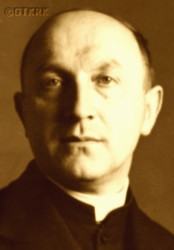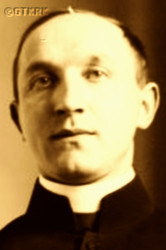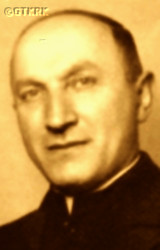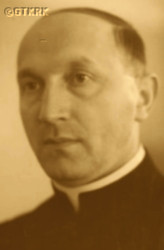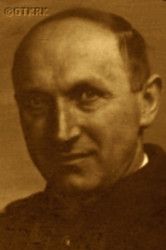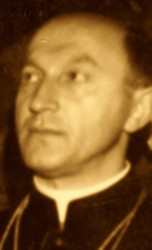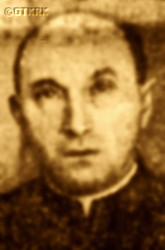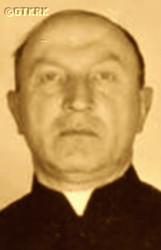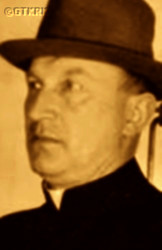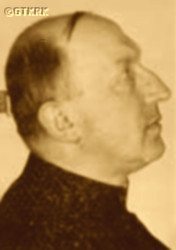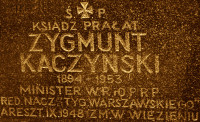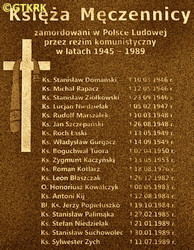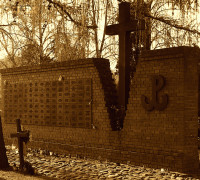Roman Catholic
St Sigismund parish
05-507 Słomczyn
85 Wiślana Str.
Konstancin deanery
Warsaw archdiocese, Poland
full list:
displayClick to display full list

searchClick to search full list by categories
wyświetlKliknij by wyświetlić pełną listę po polsku

szukajKliknij by przeszukać listę wg kategorii po polsku

Martyrology of the clergy — Poland
XX century (1914 – 1989)
personal data
surname
KACZYŃSKI
forename(s)
Sigismund (pl. Zygmunt)
function
diocesan priest
creed
Latin (Roman Catholic) Church RCmore on
en.wikipedia.org
[access: 2014.09.21]
diocese / province
Warsaw archdiocesemore on
en.wikipedia.org
[access: 2013.05.19]
RC Military Ordinariate of Polandmore on
en.wikipedia.org
[access: 2014.12.20]
academic distinctions
Canon Law MA
Sacred Theology Candidate
honorary titles
Papal chamberlainmore on
en.wikipedia.org
[access: 2014.11.22]
(1922)
„Pro Ecclesia et Pontifice”more on
en.wikipedia.org
[access: 2019.02.02]
(1922)
Minor Canonmore on
en.wikipedia.org
[access: 2014.11.14]
(1935, St John the Baptist Martyrdom RC archcathedral church, Warsawtoday: Warsaw city pov., Masovia voiv., Poland
more on
en.wikipedia.org
[access: 2021.10.09])
„Cross of Valour”more on
en.wikipedia.org
[access: 2019.04.16]
date and place
of death
13.05.1953

Warsawtoday: Warsaw city pov., Masovia voiv., Poland
more on
en.wikipedia.org
[access: 2021.10.09]
details of death
While studying at the seven‐grade 3rd Philological Gymnasium for boys in Warsaw at 3 Krakowskie Przedmieście Str., with Russian as the language of instruction, participated in the school strike in 1905. For a time expelled by the Russians — then ruling in most of the occupied Poland — from school.
During World War I, as a student in Sankt Petersburg, charities and educational organisations in Russia and Finland; among others in Support Society for War Victims in Sankt Petersburg, Central Civic Committee, organizations established after the escape (known as bezhenstvo) of c. 3 million Russian officials, teachers, soldiers, Orthodox clergy — administrators of Polish lands in the Russian partition of Poland — and their families, the result of Russian defeat in the Battle of Gorlice on 03.05.1915 by the troops of the Central Powers (Germany and Austria–Hungary). There were many Poles among them. Then an educational instructor of the Polish Soldiers Union in Vyborg (then in the Grand Duchy of Finland, headed by the Russian Tsar) and a guardian of Polish orphanages. After the fall of tsarism in 02.1917, served in the Polish Legion in Finland, formed on 24.04.1917 in Vyborg. Graduated from the local officer school, receiving the rank of infantry lieutenant. Immediately afterwards, after ordination, became the Legion's chaplain, with the rank of captain. Prob. participated on 14‐16.02.1918 in Sankt Petersburg in the 1st All–Russian Congress of Christian Democratic Delegates — called on the initiative of the Metropolitan of Mogilev, Abp Edward von Ropp — the aim of which was to establish the Christian Democratic Union of Russia.
In 1918, after the separatist peace treaty between Bolshevik Russia and the Central Powers, signed on 3.03.1918 in Brest, returned to Polish territory. Arrested by the Germans, locked up in a fortress in Brest for several weeks.
During the Polish–Russian War of 1919‐1921, chaplain of the Polish Army („flying chaplain”) — participated, among others, in in the Battle of Radzymin on 13‐16.08.1920, during the great Battle of Warsaw (known as the „Miracle on the Vistula”), which resulted in the defeat of the Russians.
After German and Russian invasion of Poland in 09.1939 and start of the World War II member of Press Office of the Warsaw Defense Committee.
Wounded on 21.09.1939.
After Warsaw fall on 28.
09.1939 and start of German occupation founded of clandestine „Active Resistance” organization functioning in Warsaw, Kraków and Zakopane (later reformed as Civil Struggle Leadership).
In danger of imminent arrest on 06.03.1940 went to Vatican where already on 10.03.1940 submitted personally to pope Pius XII a memorial about German atrocities in German occupied Poland.
Next through Switzerland moved at end of 03.1940 to France, where Polish government in exile had in Angers its HQ.
Finally after fall of France in 06.1940 moved in 10.1940 to England.
Till 1944 a member of the government of the Republic of Poland, then in exile in London.
In 04.1943, after German announcement of discovery of bodies of Polish officers murdered by Russians in Katyn forest was responsible for formally asking International Red Cross to investigate the matter.
After end of World War II hostilities returned in 09.1945 to the Russian occupied Poland.
As a parish priest led efforts to rebuild All Saints church in Warsaw, securing funds from the Polish Jewry thankful for support provided to Jews by the Catholic Church during war, among others.
On 31.08.1948 arrested for the first time by the Commie‐Nazi Polish secret police UB, branch of genocidal Russian NKVD/MGB, together with other editors of „Warsaw Weekly”.
After a week of interrogations released on 07.09.1948 — following his signature under committment to hold details in private and regular checking in UB offices.
On 26.04.1949 arrested again by the UB.
Held in Warsaw Koszykowa Str. UBgaol.
Accused of „aimig to forcibly overthrow democratic peoples' system of the Polish state”.
On 29.08.1951 tried in Warsaw and sentenced to 10 years in prison.
Held in Rakowiecka Str. Prison in Warsaw.
Tortured — suffering from sensitivity to light the guards used to leave light in his cell on permanently, repeatedly beaten.
Finally murdered — wooden box containing his body was brought to the cemetery opened, and witnesses saw his head covered by newspapers soaked in blood.
Officially passed away from „heart attack”.
cause of death
murder
perpetrators
Russians / Poles
sites and events
Warsaw (Mokotów)Click to display the description, «Intelligenzaktion»Click to display the description, GeneralgouvernementClick to display the description, Ribbentrop‐MolotovClick to display the description, Pius XI's encyclicalsClick to display the description, Polish‐Russian war of 1919‐1921Click to display the description
date and place
of birth
15.10.1894Birth certification on:
metryki.genealodzy.pl
[access: 2025.03.15]

Warsawtoday: Warsaw city pov., Masovia voiv., Poland
more on
en.wikipedia.org
[access: 2021.10.09]
parents
KACZYŃSKI Francis
🞲 1860, Kaczyn‐Herbasytoday: Czyżew gm., Wysokie Mazowieckie pov., Podlaskie voiv., Poland
more on
en.wikipedia.org
[access: 2021.12.18] — 🕆 ?, ?

JASKULSKA Josefa Gustava
🞲 1868, Strubinytoday: Zakroczym gm., Nowy Dwór Mazowiecki pov., Masovia voiv., Poland
more on
en.wikipedia.org
[access: 2025.02.22] — 🕆 22.01.1923, ?
baptism
16.10.1894Birth certification on:
metryki.genealodzy.pl
[access: 2025.03.15]

Warsawtoday: Warsaw city pov., Masovia voiv., Poland
more on
en.wikipedia.org
[access: 2021.10.09]
St Andrew the Apostle RC church
presbyter (holy orders)
ordination
1917

positions held
1946 – 1951
parish priest — Warsawtoday: Warsaw city pov., Masovia voiv., Poland
more on
en.wikipedia.org
[access: 2021.10.09] ⋄ All the Saints RC parish ⋄ Warsaw‐northdeanery name
today: Warsaw 3rd district, Warsaw city pov., Masovia voiv., Poland RC deanery
1935 – 1951
Minor Canon — Warsawtoday: Warsaw city pov., Masovia voiv., Poland
more on
en.wikipedia.org
[access: 2021.10.09] ⋄ Cathedral Chapter ⋄ St John the Baptist RC archcathedral church — i.a. in c. 1939 treasury officer / procurator of the Chapter
1947 – 1951
membership — Primate's Committee for the Rebuilding of Churches in the Capital City
1947 – 1951
membership — Supreme Reconstruction Council of the Capital City Warsaw
1945 – 1948
Editor in Chief — „Warsaw Weekly”, Catholic Publishing Society „Polish Family”
1945 – 1946
activist — Labor Faction
1943 – 1944
minister — Londontoday: London Cou., England, United Kingdom
more on
en.wikipedia.org
[access: 2024.03.19] ⋄ Ministry of Religious Denominations and Public Enlightenment, Polish government–in–exile — also: 03.02.1942‐14.07.1943 representative of the Labor Faction in the National Council of the Republic of Poland
1940 – 1943
deputy minister — Londontoday: London Cou., England, United Kingdom
more on
en.wikipedia.org
[access: 2024.03.19] ⋄ Ministry of Information and Documentation, Polish government–in–exile — till 05.1941 in Paris in France and next in London in United Kingdom
from 1940
chaplain — to Vladislav Raczkiewicz, the President of the Republic of Poland — with the dean title, in the rank of colonel of the Polish Army
1929 – 1939
director — Catholic Press Agency — also: 1930s activist of the Morges Front, the agreement linking opposition parties to the government of the so‐called Sanacja (Eng. Sanation); supporter of the unification of Christian Democratic parties, which resulted in the creation of the Labour Faction in 1937
1937
co‐organizer of the Polish Red Cross and the Society for the Protection of Prisoners during World War I
1931 – 1933
chaplain — Warsawtoday: Warsaw city pov., Masovia voiv., Poland
more on
en.wikipedia.org
[access: 2021.10.09] ⋄ Boarding School for Indigent Female Students, Divine Providence Teachers' Seminary (at 8 Myśliwiecka Str.), Germ. Karl–Franzens–Universität (Eng. Charles and Francis University) — also: prefect of elementary schools
c. 1929 – c. 1934
vicar — Warsawtoday: Warsaw city pov., Masovia voiv., Poland
more on
en.wikipedia.org
[access: 2021.10.09] ⋄ St Josaphat the Bishop and Martyr RC parish ⋄ Warsawtoday: Warsaw city pov., Masovia voiv., Poland
more on
en.wikipedia.org
[access: 2021.10.09] deanery
from 1927
prefect — Warsawtoday: Warsaw city pov., Masovia voiv., Poland
more on
en.wikipedia.org
[access: 2021.10.09] ⋄ „Cooperation” Society's gymnasium for Women
c. 1925 – 1930
student — Warsawtoday: Warsaw city pov., Masovia voiv., Poland
more on
en.wikipedia.org
[access: 2021.10.09] ⋄ canon law, Department of Catholic Theology, University of Warsaw [i.e. University of Warsaw (from 1945) / clandestine University (1939‐1945) / Joseph Piłsudski University (1935‐1939) / University of Warsaw (1915‐1935) / Imperial University of Warsaw (1870‐1915)] — postgraduate specialised studies crowned with Canon Law Master's degree
from 08.1928 editor‐in‐chief of the daily „Respublika” in Warsaw — earlier, from 1925, co‐editor (also co‐shareholder); 1922 editor of the weekly „New Life” in Grodno (also co‐owner); 1919‐1920 editor of the magazine „Polish Worker”
1922 – 1927
parliamentary deputy — Seym i.e. Parliament (1st Term), Second Polish Republic
1919 – 1922
parliamentary deputy — Seym i.e. Parliament (Legislative), Second Polish Republic
1920
RC military chaplain — Polish Armed Forces — so‐called „flying chaplain”
from 1920
membership — ChNSP Christian National Labor Faction — from 1925 Polish Party of Christian Democracy PSChD — in 1928‐1931 member of the Leadership Board
1918 – c. 1931
chaplain — WarsawSielce neighborhood
form.: till 1916 separate village
today: part of Mokotów district, Warsaw city pov., Masovia voiv., Poland
more on
en.wikipedia.org
[access: 2023.05.28] ⋄ RC chapel (Congregation of the Divine Providence Nuns CSDP) ⋄ WarsawMokotów district
today: Warsaw city pov., Masovia voiv., Poland
more on
en.wikipedia.org
[access: 2022.01.28], St Michael the Archangel RC parish ⋄ Warsaw‐in‐urbedeanery name
today: Warsaw city pov., Masovia voiv., Poland RC deanery — also: prefect of elementary schools
1917 – 1918
RC military chaplain — Vyborgtoday: Vyborg reg., Leningrad oblast, Russia
more on
en.wikipedia.org
[access: 2022.02.15] ⋄ Polish Legion in Finland, Russian army — in the rank of captain (earlier a soldier, after officer school in the rank of lieutenant)
from 1917
membership — Christian Workers Association — secretary general (1918‐1919), co–organizer (from 1917)
student — Sankt Petersburgtoday: Saint Petersburg city, Russia
more on
en.wikipedia.org
[access: 2020.07.31] ⋄ sociology and economics, Sankt Petersburg Imperial University
1914 – 1917
student — Sankt Petersburgtoday: Saint Petersburg city, Russia
more on
en.wikipedia.org
[access: 2020.07.31] ⋄ theology, Imperial Roman Catholic Spiritual Academy (1842‐1918) — postgraduate specialised studies crowned with Sacred Theology Candidate's degree
1910 – 1914
student — Warsawtoday: Warsaw city pov., Masovia voiv., Poland
more on
en.wikipedia.org
[access: 2021.10.09] ⋄ philosophy and theology, Metropolitan Theological Seminary
sites and events
descriptions
Warsaw (Mokotów): Prison and detention centre in Warsaw on Rakowiecka Str. Used by Germans during German occupation 1939‐1945 to held thousands of Poles. In 1945‐1956 thousands of Polish independence activists were held there by the Polish Commie‐Nazi branch of Russian NKVD/KGB police. Hundreds of Poles were executed. (more on: pl.wikipedia.orgClick to attempt to display webpage
[access: 2013.08.17])
«Intelligenzaktion»: German: «Intelligenzaktion» (English: „Intelligence Action”) — a German program of extermination of the Polish elite, mainly the intelligentsia and leadership layers, carried out from the beginning of the occupation in w 09.1939 to 04.1940, mainly in territories directly annexed to Germany, but also in the so‐called Germ. Generalgouvernement (Eng. General Governorate), where it was called «AB‐aktion». In the first phase, immediately after the beginning of the German occupation, during military operations carried out by the Germ. Wehrmacht (Eng. Armed Forces) and the genocidal units of the Germ. Einsatzgruppen (Eng. Operational Groups) of the Germ. Sicherheitspolizei (Eng. Security Police), i.e. SiPo, and Germ. Sicherheitsdienst des Reichsführers SS (Eng. Security Service of the Reichsführer SS), i.e. SD, organized by the Germ. Reichssicherheitshauptamt (Eng. Reich Main Security Office), i.e. RSHA, which followed the troops, carried out under the Germ. Unternehmen „Tannenberg” (Eng. Operation „Tannenberg”) — based on the so‐called Germ. Sonderfahndungsliste (Eng. Special Wanted Lists), i.e. proscription lists of Poles considered particularly dangerous to the Third Reich, prepared by the Zentralstelle II/P (Polen) unit of the German RSHA. Later, implemented by the German civilian occupation authorities and the genocidal unit of the Germ. Volksdeutscher Selbstschutz (Eng. Ethnic Germans Self‐Defense), whose members were Germ. Volksdeutsche (Eng. Ethnic Germans), i.e. representatives of the German minority in Poland. According to various sources, these lists, at the beginning of 09.1939, could have contained the details of 61,000—88,000 „dangerous” Poles — although these figures cannot be confirmed. In total, during this genocide, c. 50,000 teachers, Catholic priests, representatives of the landed gentry, freelancers, social and political activists, and retired military personnel were systematically and methodically murdered. Another 50,000 were sent to concentration camps, where only a negligible percentage survived. (more on: en.wikipedia.orgClick to attempt to display webpage
[access: 2014.10.04])
Generalgouvernement: After the Polish defeat in the 09.1939 campaign, which was the result of the Ribbentrop‐Molotov Pact and constituted the first stage of World War II, and the beginning of German occupation in part of Poland (in the other, eastern part of Poland, the Russian occupation began), the Germans divided the occupied Polish territory into five main regions. In two of them new German provinces were created, two other were incorporated into other provinces. However, the fifth part was treated separately, and in a political sense it was supposed to recreate the German idea from 1915 (during World War I, after the defeat of the Russians in the Battle of Gorlice in 05.1915) of creating a Polish enclave within Germany. Illegal in the sense of international law, i.e. Hague Convention, and public law, managed by the Germans according to separate laws — especially established for the Polish Germ. Untermenschen (Eng. subhumans) — till the Russian offensive in 1945 it constituted part of the Germ. Großdeutschland (Eng. Greater Germany). Till 31.07.1940 formally called Germ. Generalgouvernement für die besetzten polnischen Gebiete (Eng. General Government for the occupied Polish lands) — later simply Germ. Generalgouvernement (Eng. General Governorate), as in the years 1915‐1918. From 07.1941, i.e. after the German attack on 22.06.1941 against the erstwhile ally, the Russians, it also included the Galicia district, i.e. the Polish pre‐war south‐eastern voivodeships. A special criminal law was enacted and applied to Poles and Jews, allowing for the arbitrary administration of the death penalty regardless of the age of the „perpetrator”, and sanctioning the use of collective responsibility. After the end of the military conflict of the World War UU, the government of the Germ. Generalgouvernement was recognized as a criminal organization, and its leader, governor Hans Frank, guilty of war crimes and crimes against humanity and executed. (more on: en.wikipedia.orgClick to attempt to display webpage
[access: 2024.12.13])
Ribbentrop‐Molotov: Genocidal Russian‐German alliance pact between Russian leader Joseph Stalin and German leader Adolf Hitler signed on 23.08.1939 in Moscow by respective foreign ministers, Mr. Vyacheslav Molotov for Russia and Joachim von Ribbentrop for Germany. The pact sanctioned and was the direct cause of joint Russian and German invasion of Poland and the outbreak of the World War II in 09.1939. In a political sense, the pact was an attempt to restore the status quo ante before 1914, with one exception, namely the „commercial” exchange of the so‐called „Kingdom of Poland”, which in 1914 was part of the Russian Empire, fore Eastern Galicia (today's western Ukraine), in 1914 belonging to the Austro‐Hungarian Empire. Galicia, including Lviv, was to be taken over by the Russians, the „Kingdom of Poland” — under the name of the General Governorate — Germany. The resultant „war was one of the greatest calamities and dramas of humanity in history, for two atheistic and anti‐Christian ideologies — national and international socialism — rejected God and His fifth Decalogue commandment: Thou shall not kill!” (Abp Stanislav Gądecki, 01.09.2019). The decisions taken — backed up by the betrayal of the formal allies of Poland, France and Germany, which on 12.09.1939, at a joint conference in Abbeville, decided not to provide aid to attacked Poland and not to take military action against Germany (a clear breach of treaty obligations with Poland) — were on 28.09.1939 slightly altered and made more precise when a treaty on „German‐Russian boundaries and friendship” was agreed by the same murderous signatories. One of its findings was establishment of spheres of influence in Central and Eastern Europe and in consequence IV partition of Poland. In one of its secret annexes agreed, that: „the Signatories will not tolerate on its respective territories any Polish propaganda that affects the territory of the other Side. On their respective territories they will suppress all such propaganda and inform each other of the measures taken to accomplish it”. The agreements resulted in a series of meeting between two genocidal organization representing both sides — German Gestapo and Russian NKVD when coordination of efforts to exterminate Polish intelligentsia and Polish leading classes (in Germany called «Intelligenzaktion», in Russia took the form of Katyń massacres) where discussed. Resulted in deaths of hundreds of thousands of Polish intelligentsia, including thousands of priests presented here, and tens of millions of ordinary people,. The results of this Russian‐German pact lasted till 1989 and are still in evidence even today. (more on: en.wikipedia.orgClick to attempt to display webpage
[access: 2015.09.30])
Pius XI's encyclicals: Facing the creation of two totalitarian systems in Europe, which seemed to compete with each other, though there were more similarities than contradictions between them, Pope Pius XI issued in 03.1937 (within 5 days) two encyclicals. In the „Mit brennender Sorge” (Eng. „With Burning Concern”) published on 14.03.1938, condemned the national socialism prevailing in Germany. The Pope wrote: „Whoever, following the old Germanic‐pre‐Christian beliefs, puts various impersonal fate in the place of a personal God, denies the wisdom of God and Providence […], whoever exalts earthly values: race or nation, or state, or state system, representatives of state power or other fundamental values of human society, […] and makes them the highest standard of all values, including religious ones, and idolizes them, this one […] is far from true faith in God and from a worldview corresponding to such faith”. On 19.03.1937, published „Divini Redemptoris” (Eng. „Divine Redeemer”), in which criticized Russian communism, dialectical materialism and the class struggle theory. The Pope wrote: „Communism deprives man of freedom, and therefore the spiritual basis of all life norms. It deprives the human person of all his dignity and any moral support with which he could resist the onslaught of blind passions […] This is the new gospel that Bolshevik and godless communism preaches as a message of salvation and redemption of humanity”… Pius XI demanded that the established human law be subjected to the natural law of God , recommended the implementation of the ideal of a Christian state and society, and called on Catholics to resist. Two years later, National Socialist Germany and Communist Russia came together and started World War II. (more on: www.vatican.vaClick to attempt to display webpage
[access: 2023.05.28], www.vatican.vaClick to attempt to display webpage
[access: 2023.05.28])
Polish‐Russian war of 1919‐1921: War for independence of Poland and its borders. Poland regained independence in 1918 but had to fight for its borders with former imperial powers, in particular Russia. Russia planned to incite Bolshevik‐like revolutions in the Western Europe and thus invaded Poland. Russian invaders were defeated in 08.1920 in a battle called Warsaw battle („Vistula river miracle”, one of the 10 most important battles in history, according to some historians). Thanks to this victory Poland recaptured part of the lands lost during partitions of Poland in XVIII century, and Europe was saved from the genocidal Communism. (more on: en.wikipedia.orgClick to attempt to display webpage
[access: 2014.12.20])
sources
personal:
pl.wikipedia.orgClick to attempt to display webpage
[access: 2013.02.15], www.katolicy.euClick to attempt to display webpage
[access: 2021.12.19], bs.sejm.gov.plClick to attempt to display webpage
[access: 2018.09.02], metryki.genealodzy.plClick to attempt to display webpage
[access: 2025.03.15], ojs.tnkul.plClick to attempt to display webpage
[access: 2020.06.06], rpnaobczyznie.kul.plClick to attempt to display webpage
[access: 2024.12.13]
original images:
gosc.plClick to attempt to display webpage
[access: 2018.09.02], commons.wikimedia.orgClick to attempt to display webpage
[access: 2018.09.02], mtrojnar.rzeszow.opoka.org.plClick to attempt to display webpage
[access: 2013.05.19], dzieje.plClick to attempt to display webpage
[access: 2018.09.02], www.polskieradio.plClick to attempt to display webpage
[access: 2018.09.02], audiovis.nac.gov.plClick to attempt to display webpage
[access: 2018.09.02], pl.wikipedia.orgClick to attempt to display webpage
[access: 2018.09.02], niezlomni.strefa.plClick to attempt to display webpage
[access: 2018.09.02], niezlomni.strefa.plClick to attempt to display webpage
[access: 2018.09.02], niezlomni.strefa.plClick to attempt to display webpage
[access: 2018.09.02], pl.m.wikipedia.orgClick to attempt to display webpage
[access: 2014.01.06], commons.wikimedia.orgClick to attempt to display webpage
[access: 2025.08.19], pl.wikipedia.orgClick to attempt to display webpage
[access: 2014.01.06]
LETTER to CUSTODIAN/ADMINISTRATOR
If you have an Email client on your communicator/computer — such as Mozilla Thunderbird, Windows Mail or Microsoft Outlook, described at WikipediaPatrz:
en.wikipedia.org, among others — try the link below, please:
LETTER to CUSTODIAN/ADMINISTRATORClick and try to call your own Email client
If however you do not run such a client or the above link is not active please send an email to the Custodian/Administrator using your account — in your customary email/correspondence engine — at the following address:

giving the following as the subject:
MARTYROLOGY: KACZYŃSKI Sigismund
To return to the biography press below:
 Click to return to biography
Click to return to biography








